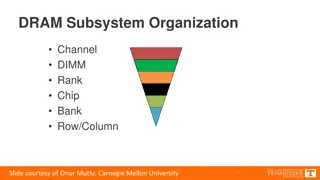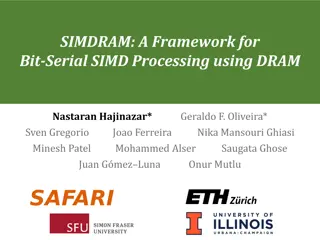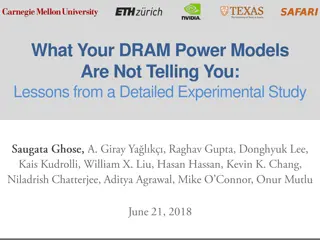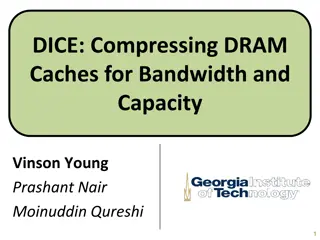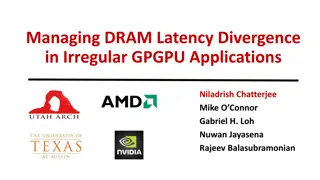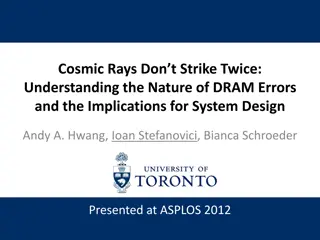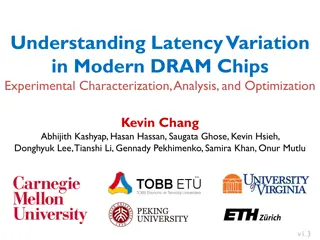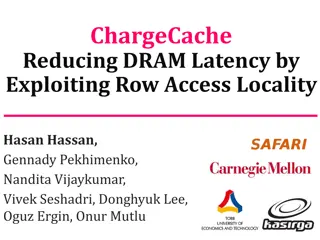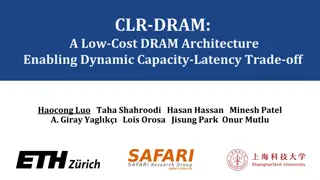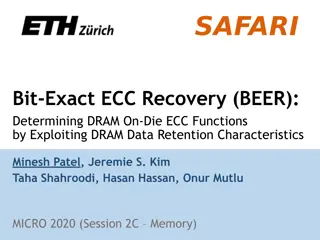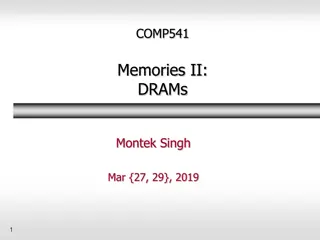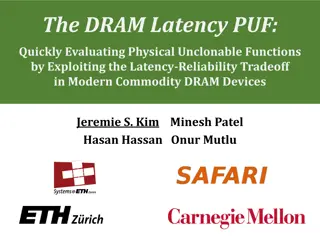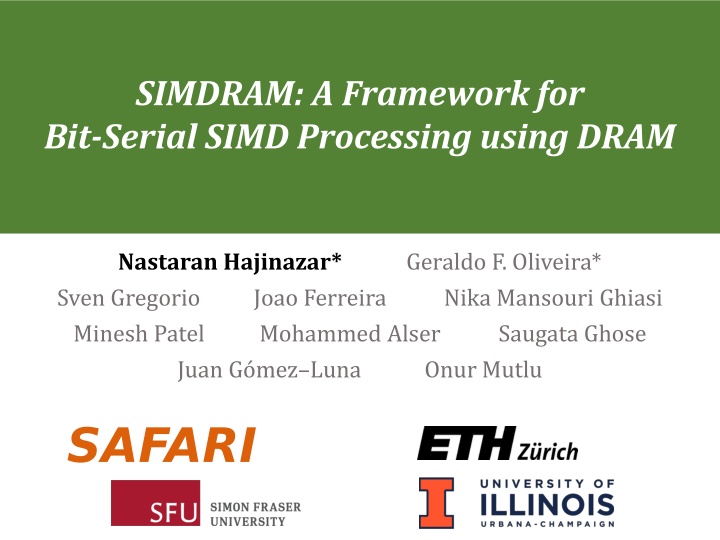
SIMDRAM: A Framework for Bit-Serial SIMD Processing using DRAM
SIMDRAM framework aims to efficiently implement complex operations in Processing-using-Memory (PuM) architectures while providing flexibility for new operations with minimal changes to DRAM. Key results show significant throughput and energy efficiency improvements compared to baseline CPU and GPU.
Download Presentation

Please find below an Image/Link to download the presentation.
The content on the website is provided AS IS for your information and personal use only. It may not be sold, licensed, or shared on other websites without obtaining consent from the author. If you encounter any issues during the download, it is possible that the publisher has removed the file from their server.
You are allowed to download the files provided on this website for personal or commercial use, subject to the condition that they are used lawfully. All files are the property of their respective owners.
The content on the website is provided AS IS for your information and personal use only. It may not be sold, licensed, or shared on other websites without obtaining consent from the author.
E N D
Presentation Transcript
SIMDRAM: A Framework for Bit-Serial SIMD Processing using DRAM Nastaran Hajinazar* Sven Gregorio Joao Ferreira Nika Mansouri Ghiasi Minesh Patel Mohammed Alser Saugata Ghose Juan G mez Luna Onur Mutlu Geraldo F. Oliveira*
Executive Summary Motivation: Processing-using-Memory (PuM) architectures can efficiently perform bulk bitwise computation Problem: Existing PuM architectures are not widely applicable Support only a limited and specific set of operations Lack the flexibility to support new operations Require significant changes to the DRAM subarray Goals: Design a processing-using-DRAM framework that: Efficiently implements complex operations Provides the flexibility to support new desired operations Minimally changes the DRAM architecture SIMDRAM: An end-to-end processing-using-DRAM framework that provides the programming interface, the ISA, and the hardware support for: 1. Efficiently computing complex operations 2. Providing the ability to implement arbitrary operations as required 3. Using a massively-parallel in-DRAM SIMD substrate that requires minimal changes to DRAM Key Results: SIMDRAM provides: 88x and 5.8x the throughput and 257x and 31x the energy efficiency of a baseline CPU and a high-end GPU, respectively, for 16 in-DRAM operations 21x and 2.1x the performance of the CPU and GPU for seven real-world applications 2
Outline 1. Processing-using-DRAM 2. Background 3. SIMDRAM Processing-using-DRAM Substrate SIMDRAM Framework 4. System Integration 5. Evaluation 6. Conclusion
Outline 1. Processing-using-DRAM 2. Background 3. SIMDRAM Processing-using-DRAM Substrate SIMDRAM Framework 4. System Integration 5. Evaluation 6. Conclusion
Data Movement Bottleneck Data movement is a major bottleneck More than 60% of the total system energy is spent on data movement1 Main Memory (DRAM) Computing Unit (CPU, GPU, FPGA, Accelerators) Memory channel Bandwidth-limited and power-hungry memory channel 5 1 A. Boroumand et al., Google Workloads for Consumer Devices: Mitigating Data Movement Bottlenecks, ASPLOS, 2018
Processing-in-Memory (PIM) Processing-in-Memory: moves computation closer to where the data resides - Reduces/eliminates the need to move data between processor and DRAM DRAM Computing Unit (CPU, GPU, FPGA, Accelerators) Memory channel 6
Processing-using-Memory (PuM) PuM: Exploits analog operation principles of the memory circuitry to perform computation - Leverages the large internal bandwidth and parallelism available inside the memory arrays A common approach for PuM architectures is to perform bulk bitwise operations - Simple logical operations (e.g., AND, OR, XOR) - More complex operations (e.g., addition, multiplication) 7
Outline 1. Processing-using-DRAM 2. Background 3. SIMDRAM Processing-using-DRAM Substrate SIMDRAM Framework 4. System Integration 5. Evaluation 6. Conclusion
Inside a DRAM Chip Bitline Wordline DRAM Cells Subarray Wordline (2D Array of DRAM Cells) Access Transistor Bitline Sense Amplifiers Row Buffer Storage Capacitor DRAM Bank DRAM Chips 8 DRAM Module
DRAM Cell Operation wordline VDD bitline access transistor storage capacitor 1. ACTIVATE (ACT) 2. READ/WRITE 3. PRECHARGE (PRE) enable sense amplifier 9
DRAM Cell Operation - ACTIVATE wordline VDD VDD + 1. Raise wordline bitline access transistor storage capacitor 1. ACTIVATE (ACT) 2. Capacitor shares charge with bitline 5. Capacitor charge is restored 2. READ/WRITE 4. Amplify deviation in the bitline 3. Enable sense amplifier 3. PRECHARGE (PRE) enable sense amplifier 6. Row buffer stores the cell value 10
DRAM Cell Operation READ/WRITE wordline VDD bitline access transistor storage capacitor 1. ACTIVATE (ACT) 2. READ/WRITE 3. PRECHARGE (PRE) enable Read/Write the value latched in sense amplifier sense amplifier 11
DRAM Cell Operation - PRECHARGE 1. Lower wordline wordline VDD2. Precharge bitline for next access VDD bitline access transistor storage capacitor 1. ACTIVATE (ACT) 2. READ/WRITE 3. PRECHARGE (PRE) 3. Disable sense amplifier enable sense amplifier 12
In-DRAM Row Copy Source row A VDD bitline Row copy command sequence2: 1. ACT Destination row B 2. ACT 3. PRE enable sense amplifier 13 2 V. Seshadri et al., RowClone: Fast and Energy-Efficient In-DRAM Bulk Data Copy and Initialization", MICRO, 2013
In-DRAM Row Copy: RowClone Source row A 3. PRECHARGE bitline Bitline pulled to value of row A for next access VDD VDD VDD 1. ACTIVATE source row A bitline Row copy command sequence2: 1. ACT Destination row B 2. ACT 2. ACTIVATE destination row B 3. PRE Charge level of source row A copied to destination row B enable sense amplifier 14 2 V. Seshadri et al., RowClone: Fast and Energy-Efficient In-DRAM Bulk Data Copy and Initialization", MICRO, 2013
Triple-Row Activation A VDD bitline Majority function command sequence3: B 1. ACT 2. PRE C enable sense amplifier 15 3 V. Seshadri et al., Ambit: In-Memory Accelerator for Bulk Bitwise Operations Using Commodity DRAM Technology", MICRO, 2017
Majority Function A VDD VDD VDD 1. ACTIVATE three rows simultaneously triple-row activation bitline Majority function command sequence3: B 1. ACT Bitline will be pulled to VDD MAJ(VDD, VDD, 0) = VDD MAJ(A, B, C ) = 2. PRE C Values in cells A, B, C overwritten with the majority output 2. PRECHARGE bitline for next access enable sense amplifier 16 3 V. Seshadri et al., Ambit: In-Memory Accelerator for Bulk Bitwise Operations Using Commodity DRAM Technology", MICRO, 2017
Ambit: In-DRAM Bulk Bitwise AND/OR A VDD bitline MAJ (A, B, 0) = AND (A, B) B MAJ (A, B, 1) = OR (A, B) C enable sense amplifier 17 V. Seshadri et al., Ambit: In-Memory Accelerator for Bulk Bitwise Operations Using Commodity DRAM Technology", MICRO, 2017
Ambit: Subarray Organization row decoder Regular Data rows 1 1 1 1 1 1 1 1 1 1 1 1 1 1 Control rows 0 0 0 0 0 0 0 0 0 0 0 0 0 0 row decoder Compute Compute rows Address A Sense amplifiers DRAM subarray 18 V. Seshadri et al., Ambit: In-Memory Accelerator for Bulk Bitwise Operations Using Commodity DRAM Technology", MICRO, 2017
Ambit: Subarray Organization row decoder Regular Data rows 1 1 1 1 1 1 1 1 1 1 1 1 1 1 Control rows 0 0 0 0 0 0 0 0 0 0 0 0 0 0 Less than 1% of overhead in existing DRAM chips Bitwise decoder Compute rows Address A Sense amplifiers DRAM subarray 18 V. Seshadri et al., Ambit: In-Memory Accelerator for Bulk Bitwise Operations Using Commodity DRAM Technology", MICRO, 2017
PuM: Prior Works DRAM and other memory technologies that are capable of performing computation using memory Shortcomings: Support only basic operations (e.g., Boolean operations, addition) - Not widely applicable Support a limited set of operations - Lack the flexibility to support new operations Require significant changes to the DRAM - Costly (e.g., area, power) 19
PuM: Prior Works DRAM and other memory technologies that are capable of performing computation using memory Shortcomings: Support only basic operations (e.g., Boolean operations, addition) - Not widely applicable Need a framework that aids general adoption of PuM, by: - Efficiently implementing complex operations Support a limited set of operations - Lack the flexibility to support new operations - Providing flexibility to support new operations Require significant changes to the DRAM - Costly (e.g., area, power) 20
Our Goal Goal: Design a PuM framework that - Efficiently implements complex operations - Provides the flexibility to support new desired operations - Minimally changes the DRAM architecture 21
Outline 1. Processing-using-DRAM 2. Background 3. SIMDRAM Processing-using-DRAM Substrate SIMDRAM Framework 4. System Integration 5. Evaluation 6. Conclusion
Key Idea SIMDRAM: An end-to-end processing-using-DRAM framework that provides the programming interface, the ISA, and the hardware support for: - Efficiently computing complex operations in DRAM - Providing the ability to implement arbitrary operations as required - Using an in-DRAM massively-parallel SIMD substrate that requires minimal changes to DRAM architecture 23
Outline 1. Processing-using-DRAM 2. Background 3. SIMDRAM Processing-using-DRAM Substrate SIMDRAM Framework 4. System Integration 5. Evaluation 6. Conclusion
SIMDRAM: PuM Substrate SIMDRAM framework is built around a DRAM substrate that enables two techniques: (2) Majority-based computation (1) Vertical data layout Cout= AB + ACin + BCin most significant bit (MSB) A 4-bit element size Row Decoder MAJ Cout B Cin least significant bit (LSB) Pros compared to the conventional horizontal layout: Pros compared to AND/OR/NOT- based computation: Implicit shift operation Massive parallelism Higher performance Higher throughput Lower energy consumption 25
Outline 1. Processing-using-DRAM 2. Background 3. SIMDRAM Processing-using-DRAM Substrate SIMDRAM Framework 4. System Integration 5. Evaluation 6. Conclusion
SIMDRAM Framework User Input SIMDRAM Output Step 1: Generate MAJ logic Step 2: Generate sequence of DRAM commands Desired operation New SIMDRAM ?Program ???????? ACT/PRE ACT/PRE ACT/PRE ACT/ACT/PRE done ?Program ???????? MAJ Main memory bbop_new MAJ/NOT logic AND/OR/NOT logic ISA New SIMDRAM instruction SIMDRAM Output Instruction result in memory User Input Step 3: Execution according to Program SIMDRAM-enabled application ACT/PRE ACT/PRE ACT/PRE ACT/PRE/PRE done ?Program foo () { ACT/PRE bbop_new } Control Unit Memory Controller 27
SIMDRAM Framework: Step 1 User Input SIMDRAM Output Step 1: Generate MAJ logic Step 2: Generate sequence of DRAM commands Desired operation New SIMDRAM ?Program ???????? ACT/PRE ACT/PRE ACT/PRE ACT/ACT/PRE done ?Program ???????? MAJ Main memory bbop_new MAJ/NOT logic AND/OR/NOT logic ISA New SIMDRAM instruction SIMDRAM Output Instruction result in memory User Input Step 3: Execution according to Program SIMDRAM-enabled application ACT/PRE ACT/PRE ACT/PRE ACT/PRE/PRE done ?Program foo () { ACT/PRE bbop_new } Control Unit Memory Controller 28
Step 1: Nave MAJ/NOT Implementation A A B 0 output is 1 only when A = B = 1 C C MAJ B A B 1 A C MAJ output is 0 only when A = B = 0 C B A 0 A MAJ B B Part 1 Cout Cout 1 MAJ MAJ 1 MAJ 0 Cin Cin Na vely converting AND/OR/NOT-implementation to MAJ/NOT-implementation leads to an unoptimized circuit 29
Step 1: Efficient MAJ/NOT Implementation Greedy optimization algorithm4 0 A A MAJ B MAJ Cout B Part 2 Cout 1 MAJ Cin MAJ 1 MAJ 0 Cin Step 1 generates an optimized MAJ/NOT-implementation of the desired operation 4L. Amar et al, Majority-Inverter Graph: A Novel Data-Structure and Algorithms for Efficient Logic Optimization , DAC, 2014. 30
SIMDRAM Framework: Step 2 User Input SIMDRAM Output Step 1: Generate MAJ logic Step 2: Generate sequence of DRAM commands Desired operation New SIMDRAM ?Program ???????? ACT/PRE ACT/PRE ACT/PRE ACT/ACT/PRE done ?Program ???????? MAJ Main memory bbop_new MAJ/NOT logic AND/OR/NOT logic ISA New SIMDRAM instruction SIMDRAM Output Instruction result in memory User Input Step 3: Execution according to Program SIMDRAM-enabled application ACT/PRE ACT/PRE ACT/PRE ACT/PRE/PRE done ?Program foo () { ACT/PRE bbop_new } Control Unit Memory Controller 31
Step 2: Program Generation Program: A series of microarchitectural operations (e.g., ACT/PRE) that SIMDRAM uses to execute SIMDRAM operation in DRAM Goal of Step 2: To generate the Program that executes the desired SIMDRAM operation in DRAM Task 1: Allocate DRAM rows to the operands Task 2: Generate Program 32
Step 2: Program Generation Program: A series of microarchitectural operations (e.g., ACT/PRE) that SIMDRAM uses to execute SIMDRAM operation in DRAM Goal of Step 2: To generate the Program that executes the desired SIMDRAM operation in DRAM Task 1: Allocate DRAM rows to the operands Task 2: Generate Program 33
Task 1: Allocating DRAM Rows to Operands Allocation algorithm considers two constraints specific to processing-using-DRAM Constraint 1: Limited number of rows reserved for computation row decoder regular 1 1 1 1 1 1 1 1 1 1 1 1 1 1 0 0 0 0 0 0 0 0 0 0 0 0 0 0 Row decoder Compute Compute rows subarray organization 34
Task 1: Allocating DRAM Rows to Operands Allocation algorithm considers two constraints specific to processing-using-DRAM Constraint 2: Destructive behavior of triple-row activation row decoder regular 1 1 1 1 1 1 1 1 1 1 1 1 1 1 0 0 0 0 0 0 0 0 0 0 0 0 0 0 Row decoder Overwritten with MAJ output Compute subarray organization 35
Task 1: Allocating DRAM Rows to Operands Allocation algorithm: Assigns as many inputs as the number of free compute rows All three input rows contain the MAJ output and can be reused Allocation algorithm A B Cin MAJ Cout 1 1 1 1 1 1 1 1 1 1 1 1 1 0 0 0 0 0 0 0 0 0 0 0 0 0 Cout Cout Cout Triple-row activation 36
Step 2: Program Generation Program: A series of microarchitectural operations (e.g., ACT/PRE) that SIMDRAM uses to execute SIMDRAM operation in DRAM Goal of Step 2: To generate the Program that executes the desired SIMDRAM operation in DRAM Task 1: Allocate DRAM rows to the operands Task 2: Generate Program 37
Task 2: Generate an initial Program Initial Program 1. Copy A to reserved row (ACT/ACT/PRE) 2. Copy B to reserved row (ACT/ACT/PRE) A B Cin Cin A B MAJ MAJ Cout Cout 3. Copy Cin to reserved row (ACT/ACT/PRE) 1. Generate Program 4. Execute MAJ (ACT/PRE) 5. Copy Cout to destination row (ACT/PRE) 38
Task 2: Optimize the Program Initial Program 1. Copy A to reserved row (ACT/ACT/PRE) 2. Copy B to reserved row (ACT/ACT/PRE) A B Cin Cin A B MAJ MAJ Cout Cout 3. Copy Cin to reserved row (ACT/ACT/PRE) 1. Generate Program 4. Execute MAJ (ACT/PRE) 5. Copy Cout to destination row (ACT/PRE) 2. Optimize 39
Task 2: Optimize the Program Initial Program 1. Copy A to reserved row (ACT/ACT/PRE) Coalesce row copies 2. Copy B to reserved row (ACT/ACT/PRE) A B Cin Cin A B MAJ MAJ Cout Cout 3. Copy Cin to reserved row (ACT/ACT/PRE) 1. Generate Program 4. Execute MAJ (ACT/PRE) 5. Copy Cout to destination row (ACT/PRE) 2. Optimize 40
Task 2: Optimize the Program Initial Program 1. Copy A to reserved row (ACT/ACT/PRE) 2. Copy B to reserved row (ACT/ACT/PRE) A B Cin Cin A B MAJ MAJ Cout Cout 3. Copy Cin to reserved row (ACT/ACT/PRE) 1. Generate Program 4. Execute MAJ (ACT/PRE) Merge MAJ + row copy 5. Copy Cout to destination row (ACT/PRE) 2. Optimize 41
Task 2: Optimize the Program Initial Program Optimized Program 1. Copy A to reserved row (ACT/ACT/PRE) 1. Copy A, B, Cin to reserved rows (ACT/ACT/PRE) Coalesce row copies 2. Copy B to reserved row (ACT/ACT/PRE) A B A B Cin Cin MAJ MAJ Cout Cout 3. Copy Cin to reserved row (ACT/ACT/PRE) 1. Generate Program 4. Execute MAJ (ACT/PRE) (ACT/ACT/PRE) 2. Execute MAJ and copy Cout to destination row Merge MAJ + row copy 5. Copy Cout to destination row (ACT/PRE) 2. Optimize 42
Task 2: Generate N-bit Computation Final Program is optimized and computes the desired operation for operands of N-bit size in a bit-serial fashion Final Program Optimized Program Repeat N times: Repeat N times: 1. Copy A, B, Cin Copy A, B, Cin to reserved rows 1. to reserved rows (ACT/ACT/PRE) (ACT/ACT/PRE) A B Cin Cin A B MAJ MAJ Cout Cout 1. Generate Program 2. Execute MAJ and copy Cout to destination row 2. Execute MAJ and copy Cout to destination row (ACT/ACT/PRE) (ACT/ACT/PRE) 2. Optimize 3. Generate N-bit computation 43
Task 2: Generate Program Final Program is optimized and computes the desired operation for operands of N-bit size in a bit-serial fashion Final Program Repeat N times: Stored in a reserved DRAM region for future use 1. to reserved rows (ACT/ACT/PRE) Copy A, B, Cin A new SIMDRAM 2. Execute MAJ and copy Cout to destination row (ACT/ACT/PRE) instruction (called bbop_new) added to CPU ISA 44
SIMDRAM Framework: Step 3 User Input SIMDRAM Output Step 1: Generate MAJ logic Step 2: Generate sequence of DRAM commands Desired operation New SIMDRAM ?Program ???????? ACT/PRE ACT/PRE ACT/PRE ACT/ACT/PRE done ?Program ???????? MAJ Main memory bbop_new MAJ/NOT logic AND/OR/NOT logic ISA New SIMDRAM instruction SIMDRAM Output Instruction result in memory User Input Step 3: Execution according to ?Program SIMDRAM-enabled application ACT/PRE ACT/PRE ACT/PRE ACT/PRE/PRE done ?Program foo () { ACT/PRE bbop_new } Control Unit Memory Controller 45
Step 3: Program Execution SIMDRAM control unit: handles the execution of the Program at runtime Upon receiving a bbop instruction, the control unit: 1. Loads the Program corresponding to SIMDRAM operation 2. Issues the sequence of DRAM commands (ACT/PRE) stored in the Program to SIMDRAM subarrays to perform the in- DRAM operation SIMDRAM Output Instruction result in memory User Input Step 3: Execution according to ?Program SIMDRAM-enabled application ACT/PRE ACT/PRE ACT/PRE ACT/ACT/PRE done foo () { ACT/PRE bbop_new } ?Program Control Unit 18 46 Memory Controller
More in the Paper Detailed reference implementation and microarchitecture of the SIMDRAM control unit 6 7 decrement is_zero Loop Counter size 1 bbop FIFO shift amount reg dst. reg src. From CPU Register Addressing Unit dst, src_1, src_2, n ?Program Scratchpad 2 bbop_op Op Op Memory +1 Register File ?Op 0 ?Op 62 ?Op 63 Proccessing FSM PC ?Op 0 ?Op 1 ?Op 62 ?Op 0 ?Op 63 / 4 branch target ?Op 0 ?Op 62 ?Op 63 ?Op 63 ?Op 16 3 To Memory Controller 5 1024 ?Program 1024 From ?Program Memory AAP/AP 47
Outline 1. Processing-using-DRAM 2. Background 3. SIMDRAM Processing-using-DRAM Substrate SIMDRAM Framework 4. System Integration 5. Evaluation 6. Conclusion



